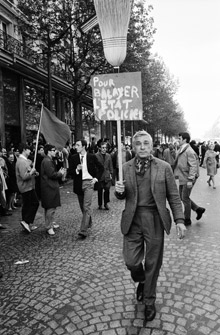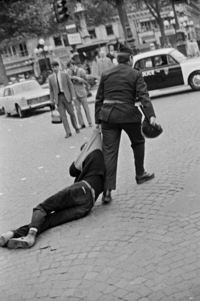After speaking with her (and eating lunch at the lovely Cafe Muse, of course), I spent the rest of my break between lectures exploring the bowels of the Berkeley Art Museum. Since I've written two papers on the Borderlandia exhibition alone, which has been running since mid-February, I've somewhat neglected the rest of the museum. So I spent some time looking at the collection of Serge Hambourg's photos from the Paris clash of 1968, and of course I gave in and bought the gorgeous catalogue (which is, as we speak, arranged lovingly on my bookshelf which is already overflowing).

I've been unable to find most of the images online, so I'll provide a description of the work: Hambourg (at the time a photographer for a French tabloid magazine) photographed in black and white the riots and protests that eventually led to the fall of the French de Gaulle government. The photographs themselves are artfully captured images of the face of the revolution and of the sentiment that powered the movement itself. The protesters were of all classes and creeds, but there was an enormous student faction that was wildly successful in its actions.

Of course most of my favorite images were those I was unable to find online, and which were the most revealing as to the strong student presence in the Paris protests of 1968. I guess what I found compelling when I viewed the entire exhibition was this glimpse of what a student revolution would actually look like. I go to the University of California, Berkeley, which everyone knows is a hotbed for revolutionary action and reformist fervor. Right? Wrong. The Berkeley of the 1960s and 1970s was an important base of operations for student movements fighting for a range of causes, but the students here now (sadly, myself more often than not included) are more occupied with creative ways to get A's without working for it than championing the weak and the oppressed.

In Hambourg's photographs, I identify with these students who, dissatisfied with their government, united in revolutionary fervor. And yet I am saddened by the fact that this kind of revolution seems so impossible in the United States of today, where students are often dismissed as children and no one really cares. What Hambourg's photos (and any kind of documentation of various student movements of the 1960s) make me really want is this kind of unitary action on the part of today's students. Are we so spread out as a generation that fighting effectively for a cause is impossible?
No comments:
Post a Comment